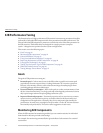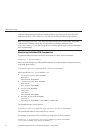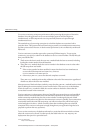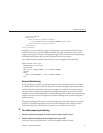
Use version consistency to improve performance while protecting the integrity of data in the
database. Since the application server can use multiple copies of an EJB component
simultaneously, an EJB component’s state can potentially become corrupted through
simultaneous access.
The standard way of preventing corruption is to lock the database row associated with a
particular bean. This prevents the bean from being accessed by two simultaneous transactions
and thus protects data. However, it also decreases performance, since it eectively serializes all
EJB access.
Version consistency is another approach to protecting EJB data integrity. To use version
consistency, you specify a column in the database to use as a version number. The EJB lifecycle
then proceeds like this:
■
The rst time the bean is used, the ejbLoad() method loads the bean as normal, including
loading the version number from the database.
■
The ejbStore() method checks the version number in the database versus its value when
the EJB component was loaded.
■
If the version number has been modied, it means that there has been simultaneous
access to the EJB component and ejbStore() throws a
ConcurrentModificationException.
■
Otherwise, ejbStore() stores the data and completes as normal.
The ejbStore() method performs this validation at the end of the transaction regardless of
whether any data in the bean was modied.
Subsequent uses of the bean behave similarly, except that the ejbLoad() method loads its initial
data (including the version number) from an internal cache. This saves a trip to the database.
When the ejbStore() method is called, the version number is checked to ensure that the
correct data was used in the transaction.
Version consistency is advantageous when you have EJB components that are rarely modied,
because it allows two transactions to use the same EJB component at the same time. Because
neither transaction modies the data, the version number is unchanged at the end of both
transactions, and both succeed. But now the transactions can run in parallel. If two transactions
occasionally modify the same EJB component, one will succeed and one will fail and can be
retried using the new values—which can still be faster than serializing all access to the EJB
component if the retries are infrequent enough (though now your application logic has to be
prepared to perform the retry operation).
To use version consistency, the database schema for a particular table must include a column
where the version can be stored. You then specify that table in the sun-cmp-mapping.xml
deployment descriptor for a particular bean:
<entity-mapping>
<cmp-field-mapping>
EJB PerformanceTuning
SunGlassFishEnterpriseServer2.1PerformanceTuningGuide • January200940


















